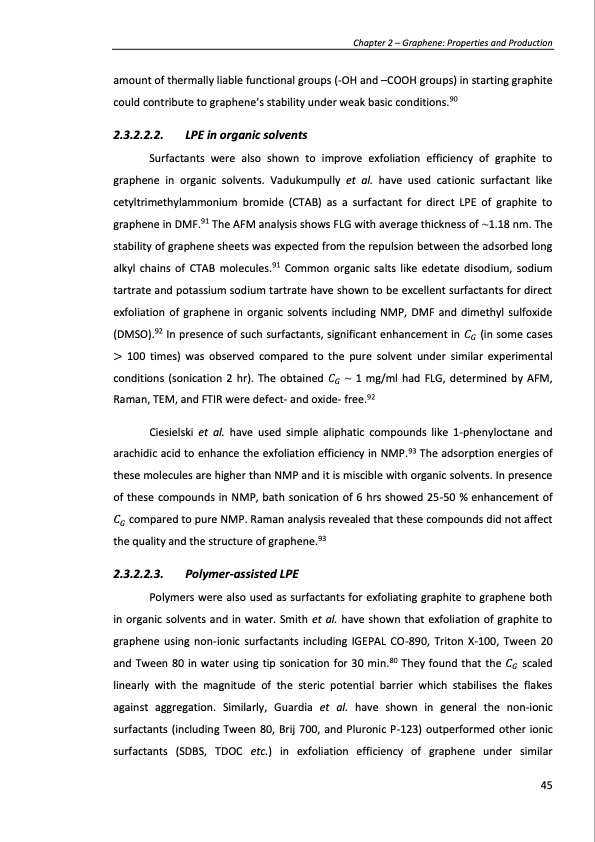PDF Publication Title:
Text from PDF Page: 045
amount of thermally liable functional groups (-OH and –COOH groups) in starting graphite could contribute to graphene’s stability under weak basic conditions.90 2.3.2.2.2. LPE in organic solvents Surfactants were also shown to improve exfoliation efficiency of graphite to graphene in organic solvents. Vadukumpully et al. have used cationic surfactant like cetyltrimethylammonium bromide (CTAB) as a surfactant for direct LPE of graphite to graphene in DMF.91 The AFM analysis shows FLG with average thickness of ~1.18 nm. The stability of graphene sheets was expected from the repulsion between the adsorbed long alkyl chains of CTAB molecules.91 Common organic salts like edetate disodium, sodium tartrate and potassium sodium tartrate have shown to be excellent surfactants for direct exfoliation of graphene in organic solvents including NMP, DMF and dimethyl sulfoxide (DMSO).92 In presence of such surfactants, significant enhancement in 𝐶𝐺 (in some cases > 100 times) was observed compared to the pure solvent under similar experimental conditions (sonication 2 hr). The obtained 𝐶𝐺 ~ 1 mg/ml had FLG, determined by AFM, Raman, TEM, and FTIR were defect- and oxide- free.92 Ciesielski et al. have used simple aliphatic compounds like 1-phenyloctane and arachidic acid to enhance the exfoliation efficiency in NMP.93 The adsorption energies of these molecules are higher than NMP and it is miscible with organic solvents. In presence of these compounds in NMP, bath sonication of 6 hrs showed 25-50 % enhancement of 𝐶𝐺 compared to pure NMP. Raman analysis revealed that these compounds did not affect the quality and the structure of graphene.93 2.3.2.2.3. Polymer-assisted LPE Polymers were also used as surfactants for exfoliating graphite to graphene both in organic solvents and in water. Smith et al. have shown that exfoliation of graphite to graphene using non-ionic surfactants including IGEPAL CO-890, Triton X-100, Tween 20 and Tween 80 in water using tip sonication for 30 min.80 They found that the 𝐶𝐺 scaled linearly with the magnitude of the steric potential barrier which stabilises the flakes against aggregation. Similarly, Guardia et al. have shown in general the non-ionic surfactants (including Tween 80, Brij 700, and Pluronic P-123) outperformed other ionic surfactants (SDBS, TDOC etc.) in exfoliation efficiency of graphene under similar Chapter 2 – Graphene: Properties and Production 45PDF Image | PRODUCTION AND APPLICATIONS OF GRAPHENE AND ITS COMPOSITES

PDF Search Title:
PRODUCTION AND APPLICATIONS OF GRAPHENE AND ITS COMPOSITESOriginal File Name Searched:
graphene-production-applications.PDFDIY PDF Search: Google It | Yahoo | Bing
Salgenx Redox Flow Battery Technology: Power up your energy storage game with Salgenx Salt Water Battery. With its advanced technology, the flow battery provides reliable, scalable, and sustainable energy storage for utility-scale projects. Upgrade to a Salgenx flow battery today and take control of your energy future.
CONTACT TEL: 608-238-6001 Email: greg@infinityturbine.com (Standard Web Page)